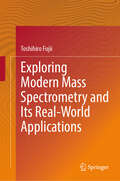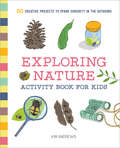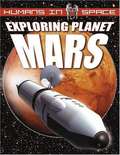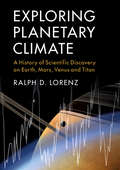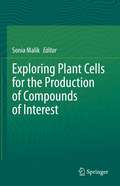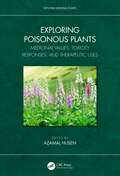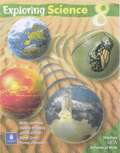- Table View
- List View
Exploring Modern Mass Spectrometry and Its Real-World Applications
by Toshihiro FujiiThis book provides an insight into the depth and rich possibilities of the sophisticated technology of mass spectrometry that has brought Nobel Prizes to seven successive generations of scientists. The book first introduces the principles of mass spectrometry and how it will continue to change our lives. It is, so to speak, a reportage on the front lines. Then, this cutting-edge technology is briefly explained. By this, the author introduces both science and humanities majors alike to consider "what new worlds have been opened up by the power of measuring molecules," and how science is being applied to our society. This book covers the 100-year history of mass spectrometry and trends in a wide range of fields such as the latest medical diagnostics, environmental science, personal safety, and food safety. It also serves as an excellent introduction to the study of mass spectrometry. It provides easy access for those who intend to work or conduct research using mass spectrometry techniques, such as science and engineering technicians, graduate students, physicians, pharmacists, and clinical technologists. For those already engaged in the field, it will be helpful in learning about the latest trends and predicting future developments.
Exploring Nature Activity Book for Kids: 50 Creative Projects to Spark Curiosity in the Outdoors
by Kim AndrewsExplore the great outdoors with this hands-on activity book for ages 6 to 12!Track, explore, discover, and create! This incredible choice in nature books for kids is full of activities you can bring on your adventures through your backyard, the park, the woods, and beyond. No matter the weather or where you live, Exploring Nature Activity Book for Kids shows you how to dive into fun and games like crafting bird feeders out of fruit, pressing flowers, or building a sundial to tell the time. Get ready to get your hands dirty and your imagination revving as you get active outside.50 fun outdoor projects—Spark your curiosity and creativity with 50 nature activities for kids that let you observe animals, plants, and even outer space!Activities for anytime—This book includes a range of activities like taking a walk, drawing pictures, and looking out your window, so there's always one to try, wherever you are.Learn to explore like a pro—When you notice and record what's going on around you, you also practice important skills like observation, memory, writing, drawing, and outdoor safety.Experience everything nature has to offer with the Exploring Nature Activity Book for Kids—and write down even more about what you see and do with the companion journal, the Exploring Nature Journal for Kids.
Exploring Opportunities for STEM Teacher Leadership: Summary of a Convocation
by Steve OlsonMany national initiatives in K-12 science, technology, engineering, and mathematics (STEM) education have emphasized the connections between teachers and improved student learning. Much of the discussion surrounding these initiatives has focused on the preparation, professional development, evaluation, compensation, and career advancement of teachers. Yet one critical set of voices has been largely missing from this discussion - that of classroom teachers themselves. To explore the potential for STEM teacher leaders to improve student learning through involvement in education policy and decision making, the National Research Council held a convocation in June 2014 entitled "One Year After Science's Grand Challenges in Education: Professional Leadership of STEM Teachers through Education Policy and Decision Making. " This event was structured around a special issue of Science magazine that discussed 20 grand challenges in science education. The authors of three major articles in that issue - along with Dr. Bruce Alberts, Science's editor-in-chief at the time - spoke at the convocation, updating their earlier observations and applying them directly to the issue of STEM teacher leadership. The convocation focused on empowering teachers to play greater leadership roles in education policy and decision making in STEM education at the national, state, and local levels. "Exploring Opportunities for STEM Teacher Leadership" is a record of the presentations and discussion of that event. This report will be of interest to STEM teachers, education professionals, and state and local policy makers.
Exploring Planet Mars (Humans In Space)
by David Jefferis Mat IrvineExploring Planet Mars looks at the scientific facts about Earth's nearest neighbor and delves into future exploration of the planet--possibly even colonization! Discoveries from the recent probes sent to the planet will be discurred and whether or not they help confirm signs of life on Mars.
Exploring Planetary Climate: A History of Scientific Discovery on Earth, Mars, Venus and Titan
by Ralph D. LorenzThis book chronicles the history of climate science and planetary exploration, focusing on our ever-expanding knowledge of Earth's climate, and the parallel research underway on some of our nearest neighbours: Mars, Venus and Titan. From early telescopic observation of clouds and ice caps on planetary bodies in the seventeenth century, to the dawn of the space age and the first robotic planetary explorers, the book presents a comprehensive chronological overview of planetary climate research, right up to the dramatic recent developments in detecting and characterising exoplanets. Meanwhile, the book also documents the discoveries about our own climate on Earth, not only about how it works today, but also how profoundly different it has been in the past. Highly topical and written in an accessible and engaging narrative style, this book provides invaluable historical context for students, researchers, professional scientists, and those with a general interest in planetary climate research.
Exploring Plant Cells for the Production of Compounds of Interest
by Sonia MalikNatural compounds obtained from plants represent a tremendous global market due to their use as food additives, cosmetics, in agriculture and in pharmaceuticals. This book provides up-to-date information on various strategies and methods for producing compounds of interest. Leading researchers discuss the latest advances in environmentally friendly natural compound production from plants, making the book a valuable resource for biotechnologists, pharmacists, food technologists and researchers working in the medical and healthcare industries.
Exploring Plate Tectonics, Student Guide
by National Science Resources Center John Norton Meg TownNIMAC-sourced textbook
Exploring Poisonous Plants: Medicinal Values, Toxicity Responses, and Therapeutic Uses (Exploring Medicinal Plants)
by Azamal HusenPoisonous plants are used in traditional medicine systems in various healing therapies. They are a rich resource of ingredients used in herbal drug formulations that are also used in the development of synthetic drugs. They are recognized for their antioxidant, anti-inflammation, anti-cancer, and anti-diabetic activities and for many other health benefits. Exploring Poisonous Plants: Medicinal Values, Toxicity Responses, and Therapeutic Uses provides an analysis of the most important poisonous herbs, shrubs, and trees, detailing poisonous plants while demonstrating endorsements for their potential therapeutic values. Features: Presents therapeutic potentials on various poisonous herbs, shrubs, and trees. Provides descriptions of notable toxic compounds and discusses their adverse effects when consumed by animals or people. Gives practical guidance for botanical description, distribution, phytochemical constituents, pharmacological studies, and traditional and other potential uses of selected poisonous plants. This volume in the Exploring Medicinal Plants series is appropriate for scientists, researchers, and students working with poisonous plants, as well as in areas of economic botany, plant biochemistry, biotechnology, pharmacognosy, pharmaceuticals, industrial chemistry, and nanomedicine.
Exploring Protein Structure: Principles and Practice (Learning Materials in Biosciences)
by Tim SkernThis textbook introduces the basics of protein structure and logically explains how to use online software to explore the information in protein structure databases. Readers will find easily understandable, step-by step exercises and video-trainings to support them in grasping the fundamental concepts.After reading this book, readers will have the skills required to independently explore and analyze macromolecular structures, will be versed in extracting information from protein databases and will be able to visualize protein structures using specialized software and on-line algorithms. This book is written for advanced undergraduates and PhD students wishing to use information from structural biology in their assignments and research and will be a valuable source of information for all those interested in applied and theoretical aspects of structural biology.
Exploring Psychology (6th Edition)
by David G. MyersPreface -- Thinking critically with psychological science -- Neuroscience and behavior -- The nature and nurture of behavior -- The developing person -- Sensation and perception -- States of consciousness -- Learning -- Memory -- Thinking, language, and intelligence -- Motivation -- Emotions, stress, and health -- Personality -- Psychological disorders -- Therapy -- Social psychology
Exploring Quantum Contextuality with Photons (Springer Theses)
by Zheng-Hao LiuThis thesis highlights research explorations in quantum contextuality with photons.Quantum contextuality is one of the most intriguing and peculiar predictions of quantum mechanics. It is also a cornerstone in modern quantum information science. It is the origin of the famous quantum nonlocality and various nonclassical paradoxes. It is also a resource for many quantum information processing tasks and even universal quantum computing. Therefore, the study of quantum contextuality not only advances the comprehension of the foundations of quantum physics, but also facilitates the practical applications of quantum information technology.In the last fifteen years, the study of quantum contextuality has developed from a purely theoretical level to a stage where direct experimental tests become amenable. However, the experimental research on contextuality at the current stage largely focuses on direct validations of some most famous predictions of contextuality, while other forms of contextuality and its practical applications in quantum information science are rarely involved. The research in this thesis is committed to bridge this gap from two directions: (1) to construct and test stronger forms of contextuality and relieve the requirements of contextuality experiments on experimental platforms, and (2) to explore the connections between contextuality and the other concepts in quantum information science and directly demonstrate the application of contextuality in broader scenarios. Specifically, the thesis have discussed the research topics about the relationship between quantum contextuality and nonlocality, the “all-versus-nothing” paradoxes from quantum contextuality, the ore- and post-selection paradoxes from quantum contextuality, and the topological protection and braiding dynamics of quantum contextuality in quasiparticle systems.
Exploring Quantum Physics through Hands-on Projects
by David Prutchi Shanni R. PrutchiBuild an intuitive understanding of the principles behind quantum mechanics through practical construction and replication of original experiments With easy-to-acquire, low-cost materials and basic knowledge of algebra and trigonometry, Exploring Quantum Physics through Hands-on Projects takes readers step by step through the process of re-creating scientific experiments that played an essential role in the creation and development of quantum mechanics. Presented in near chronological order--from discoveries of the early twentieth century to new material on entanglement--this book includes question- and experiment-filled chapters on: Light as a Wave Light as Particles Atoms and Radioactivity The Principle of Quantum Physics Wave/Particle Duality The Uncertainty Principle Schrödinger (and his Zombie Cat) Entanglement From simple measurements of Planck's constant to testing violations of Bell's inequalities using entangled photons, Exploring Quantum Physics through Hands-on Projects not only immerses readers in the process of quantum mechanics, it provides insight into the history of the field--how the theories and discoveries apply to our world not only today, but also tomorrow. By immersing readers in groundbreaking experiments that can be performed at home, school, or in the lab, this first-ever, hands-on book successfully demystifies the world of quantum physics for all who seek to explore it--from science enthusiasts and undergrad physics students to practicing physicists and engineers.
Exploring Reality: The Intertwining of Science and Religion
by John PolkinghorneReality is multi-layered, asserts the Reverend John Polkinghorne, and in this insightful book he explores various dimensions of the human encounter with reality. Through a well-reasoned and logical process, Polkinghorne argues that reality consists not only of the scientific processes of the natural world but also the personal dimension of human nature and its significance. He offers an integrated view of reality, encompassing a range of insights deriving from physics' account of causal structure, evolutionary understanding of human nature, the unique significance of Jesus of Nazareth, and the human encounter with God.
Exploring Respiration and Circulation, Student Guide
by National Science Resources Center Wordwise Inc. Taina LitwakNIMAC-sourced textbook
Exploring Science
by Cengage Learning National Geographic LearningThis student edition covers 100% of Grade 4 Next Generation Science Standards.
Exploring Science
by National Geographic LearningExploring Science Student Books were created to teach the 3-Dimensions of the NGSS, preparing students to master the Performance Expectations through engaging images and text, through hands-on investigations and STEM projects, and through the introduction of National Geographic Explorers, scientists, and engineers.
Exploring Science 1: Student Edition
by Cengage Learning National Geographic LearningThis student edition covers 100% of Grade 1 Next Generation Science Standards. Features: Focus in-depth on 100% of the NGSS for grades K-5. Introduce real-world science research with National Geographic Explorers, scientists, and photographers. Connect NGSS content with investigations, engineering practices, and case studies for complete NGSS emersion. Can be combined with National Geographic Science for the most complete NGSS solution available
Exploring Science 8
by Mark Levesley Sandra Baggley Julian Clarke Steve Gray Penny Johnson Andrea CoatesThis edition of Exploring Science 8 focuses on Biology and Chemistry.
Exploring Science Through Science Fiction (Science and Fiction)
by Barry B. LuokkalaHow does Einstein’s description of space and time compare with Doctor Who? Can James Bond really escape from an armor-plated railroad car by cutting through the floor with a laser concealed in a wristwatch? What would it take to create a fully intelligent android, such as Star Trek’s Commander Data? Exploring Science Through Science Fiction addresses these and other intriguing questions, using science fiction as a springboard for discussing fundamental science concepts and cutting-edge science research. It includes references to original research papers, landmark scientific publications and technical documents, as well as a broad range of science literature at a more popular level. The revised second edition includes expanded discussions on topics such as gravitational waves and black holes, machine learning and quantum computing, gene editing, and more. In all, the second edition now features over 220 references to specific scenes in more than 160 sci-fi movies and TV episodes, spanning over 100 years of cinematic history. Designed as the primary text for a college-level course, this book will appeal to students across the fine arts, humanities, and hard sciences, as well as any reader with an interest in science and science fiction.Praise for the first edition:"This journey from science fiction to science fact provides an engaging and surprisingly approachable read..." (Jen Jenkins, Journal of Science Fiction, Vol. 2 (1), September 2017)
Exploring Science [Grade 2]
by Malcolm B. Butler Kathy Cabe Trundle Randy L. BellThis student edition covers 100% of Grade 2 Next Generation Science Standards.
Exploring Science [Grade 2]
by Malcolm B. Butler Kathy Cabe Trundle Randy L. BellNIMAC-sourced textbook
